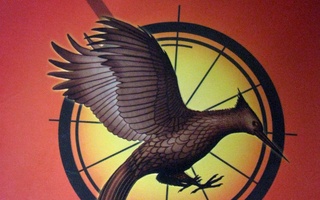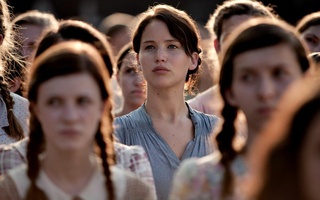“The Hunger Games: Catching Fire” is a rare and exciting film: an adaptation that adheres nearly perfectly to its source material, a sequel that improves upon its predecessor, and a non-stop thrill ride of an action movie packed with social commentary. “The Hunger Games,” released in March of last year, was a similarly faithful and riveting adaptation. Yet under the helm of new franchise director Francis Lawrence, this film explores even darker and more ominous aspects of the country of Panem than the eponymous games: the vast political machinations underlying this futuristic totalitarian world. Grounded by grand world-building, a superb supporting cast, and the always-electric Jennifer Lawrence, “Catching Fire” is a powerfully acted and fantastically imagined glimpse into a frightening future.
The film opens back home in District 12, where wintry mists blanket the Appalachian coal mines and a post-traumatic Katniss (Jennifer Lawrence) attempts to put her life back together after surviving the 74th Hunger Games. Francis Lawrence wastes no time in establishing this as a darker world than the previous film. Rather than the bleak summer of creaking cottages and lined faces that filled the opening minutes of “The Hunger Games,” we see instead a cold, gray, industrial landscape where Katniss cannot shoot an arrow without flashing back to a boy she killed.
But the novel did not linger on home, and neither can the film. Katniss and Peeta (Josh Hutcherson) are soon back in the Capitol, first to be lauded as victors and later to participate in a politically motivated second Hunger Games—this one intended to kill as many victors as possible by throwing them into a new arena together. The first 80 minutes or so of the film lead up to this moment, but there is nary a dull second, for the world outside the arena is as dangerous as that within. This epic exploration is one of the most successful expansions from the first film.
As Katniss, Peeta, and their eclectic entourage speed by train through the country, they both witness and inadvertently ignite acts of revolution wherever they go. For the passively placated citizens of the Capitol, Katniss and Peeta are the “lethal lovers from District 12,” though their romance is strategic rather than genuine; but for the poor, disenfranchised masses that fill the other 11 districts, they are a symbol of hope that will soon explode into violent defiance. The world of Panem comes to life as viscerally on film as it did in the novel: from the penned-in and violently patrolled agricultural district to the sterile and Grecian capitol, there is grandeur in this world-building that effectively expands Katniss’s horizons beyond her home and the arena. She may be a gladiator for the new age, but this time, we get to see all of Rome.
Jennifer Lawrence anchors the film with frightfully convincing ferocity in a performance that could be called career-making had she not already proven herself several times over. In the space of five seconds, fear, shock, panic, and insanity flit across her face. In other sequences, she is as capable at hanging like a broken marionette doll at the tribute selection ceremony (known as the “reaping”) as she is at striding darkly and defiantly across a stage to play sycophant to her fawning Capitol audience. While her powerful performance tended at times to overwhelm other actors in the previous film, here they rise to the occasion. Hutcherson’s transformation is especially notable, taking him from a love-struck weakling to an equally compelling companion. Newcomers Finnick (Sam Claflin) and Johanna (Jena Malone), fellow victors-turned-tributes, encapsulate their characters’ most-loved attributes of charm and abrasiveness. From Woody Harrelson in his reprisal of the role of Haymitch Abernathy to Philip Seymour Hoffman’s introduction as Plutarch Heavensbee, these actors are perfectly cast, and their chemistry elevates the ensemble from mere role-playing to role-inhabiting. By the end of the film, even Hoffman, as recognizable as he may be, disappears into his character.
With a similar, if expanded, plot to the first film, “Catching Fire” could easily have come across as “The Hunger Games 2,” a mere stepping stone on the way to the vastly different world of the series’s third installment, “Mockingjay.” “Catching Fire” may be a sequel, but its insidious backbone, full of foreboding and a dark psychological tone, marks it as a film unto itself. It succeeds as a companion piece and an adaptation by clearly moving the series forward. Dark though this world may be, in this consistently heart-pounding and compelling adaptation, it is one we may not want to leave.
—Staff writer Leanna B. Ehrlich can be reached at leanna.ehrlich@thecrimson.com.
Read more in Arts
8 Way to Prepare for 'The Hunger Games: Catching Fire' PremiereRecommended Articles
-
Institute of Politics Announces Spring FellowsThe Institute of Politics' spring Fellows Program will include two former members of the House of Representatives, a White House senior speechwriter, and a senior political adviser to U.S. generals in Iraq, among others.
-
 'The Hunger Games' Drinking Games
'The Hunger Games' Drinking Games -
The Gender-Neutral GamesThe Hunger Games largely avoids the restrictive lens of gender. Within Collins’ literary world, Katniss is characterized neither as feminine nor as feminist; she is merely a complex, humanized character.
-
 ‘Hunger Games’ Will Sate Book’s Fans
‘Hunger Games’ Will Sate Book’s Fans -
The Odds Ever in Our FavorAs far as I was concerned, the freshman world was dog-eat-dog, tribute-spear-tribute. With every day came a new rush toward the Cornucopia to gather items perceived as essential to survival. Some were harder to acquire than others. Everyone could lay their hands on everyday necessities like those in Katniss’s backpack: an umbrella, a Snuggie, Advil, Adderall, condoms.
-
 Harvard Today: Oct. 15, 2013
Harvard Today: Oct. 15, 2013














